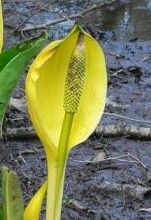 The name only tells half the story. Yes, the plant does have a distinct skunk smell but its very large green leaves and bright yellow sheaths make it a knockout in the wet woods or swampy areas it calls home. Western skunk cabbage belongs to the Arum family and has the unique inflorescence typical of that family. The yellow sheath, called a spathe, surrounds and protects the spadix, the fleshy spike that produces the tiny greenish flowers. Skunk cabbage is one of the first plants to emerge in the spring, often coming through the snow because of the heat the spadix produces. The plant is also called swamp lantern because of the yellow spathe and Indian waxpaper because the large leaves were used by indigenous people for food preparation.
The name only tells half the story. Yes, the plant does have a distinct skunk smell but its very large green leaves and bright yellow sheaths make it a knockout in the wet woods or swampy areas it calls home. Western skunk cabbage belongs to the Arum family and has the unique inflorescence typical of that family. The yellow sheath, called a spathe, surrounds and protects the spadix, the fleshy spike that produces the tiny greenish flowers. Skunk cabbage is one of the first plants to emerge in the spring, often coming through the snow because of the heat the spadix produces. The plant is also called swamp lantern because of the yellow spathe and Indian waxpaper because the large leaves were used by indigenous people for food preparation.
Type: Herbaceous perennial
Bloom: Tiny greenish flowers are produced on a spadix in early spring.
Foliage: Leaves are shiny green, up to a yard long and emerge after the flowers.
Size: 1-5’ H x 1-2’ W
Light: Full sun to full shade
Soil: Fertile, wet
Fertilizer: Apply high potassium fertilizer to encourage flowering.
Hardiness: Zones 6-9
Pests and Diseases: None of significance
Propagation: Seed; division
Companion plants: Bog and swamp plants like marsh marigold (Caltha biflora)
Outstanding Selection: The English have developed skunk cabbages with larger spathes.
